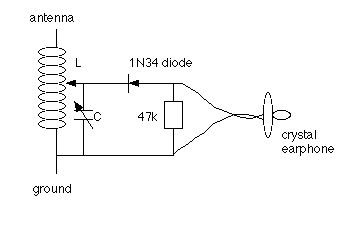

I found that the
best place to connect the antenna and ground depended on the antenna used
and probably on local conditions. Sometimes connecting the antenna to the
slider worked well. I tried the detector tap at the top of the coil,
as some designs do, but selectivity really suffered. Some selectivity
improvement was seen when I wound a smaller coil for an antenna loading
coil and put it up inside the tuning coil. Again, you can still play
with where the antenna and ground are connected; you can put the antenna
or ground to the loading coil, and try the other on either end of the tuning
coil or on the detector connection. You can also make your earth
ground to both the loading coil and the tuning coil. The best arrangement
is what works best for you. An operating benefit of connecting the
detector to the slider is that you don't hear anything unless the slider
is making contact with the coil.
My latest design
attempt, which shows promise in the breadboard stage, goes back to a fixed
capacitor in the tank circuit , but incorporates an antenna loading coil
and separate detector taps, two features which I consider essential to
selectivity in a single tuned set. The drawing for this rig is shown
below:

My coil was 100
turns of #26 magnet wire close-wound on a toilet paper core, with detector
taps at 10, 20, and 30 turns from the bottom (connected) end. The antenna
coil, L2, is 15 turns of #26, also on a tp core. I chose to separate
the coils so I could move the antenna coil about to vary coupling, but
could probably have done about as well winding both coils on the same core
with about a 1/8 to 1/4 inch separation between them. Note:
I found that the loading coil had to be placed at the bottom end
of L1 as shown; placing it at the open end didn't work very well at all
(for me). For a slider, I just straightened out a large paper clip,
soldered it with a stranded hookup wire into a soldering lug, and then
used a wood screw to hold the slider to the base I used. Just for
grins I rolled my own fixed capacitor, C1, making it about 300pF.
On the air results were pretty good.
The detector tap is selected by an alligator clip. I got the separation
I wanted between the two strong locals that are 50 kHz apart, sensitivity
is ok, BUT, the rig design still needs some work before I offer it to my
students. Current problems and possible solutions:
a. Only
using about half the coil, and it tunes pretty fast - use larger wire,
maybe a smaller diameter coil form, and maybe a smaller value capacitor.
(probably do at least two of the three)
b. Not happy
with the paper clip slider; too flexible so you get backlash, and doesn't
ride smoothly - use a metal strip and maybe add another washer where it
connects to the base.
c.
With detector tapped directly to the coil, you always hear something, whether
or not the slider is making contact. I guess I can live with this.
HOME LINKS CONSTRUCTION TIPS COMMENTS ANTENNAS TESTING REVIEW PROJECTS